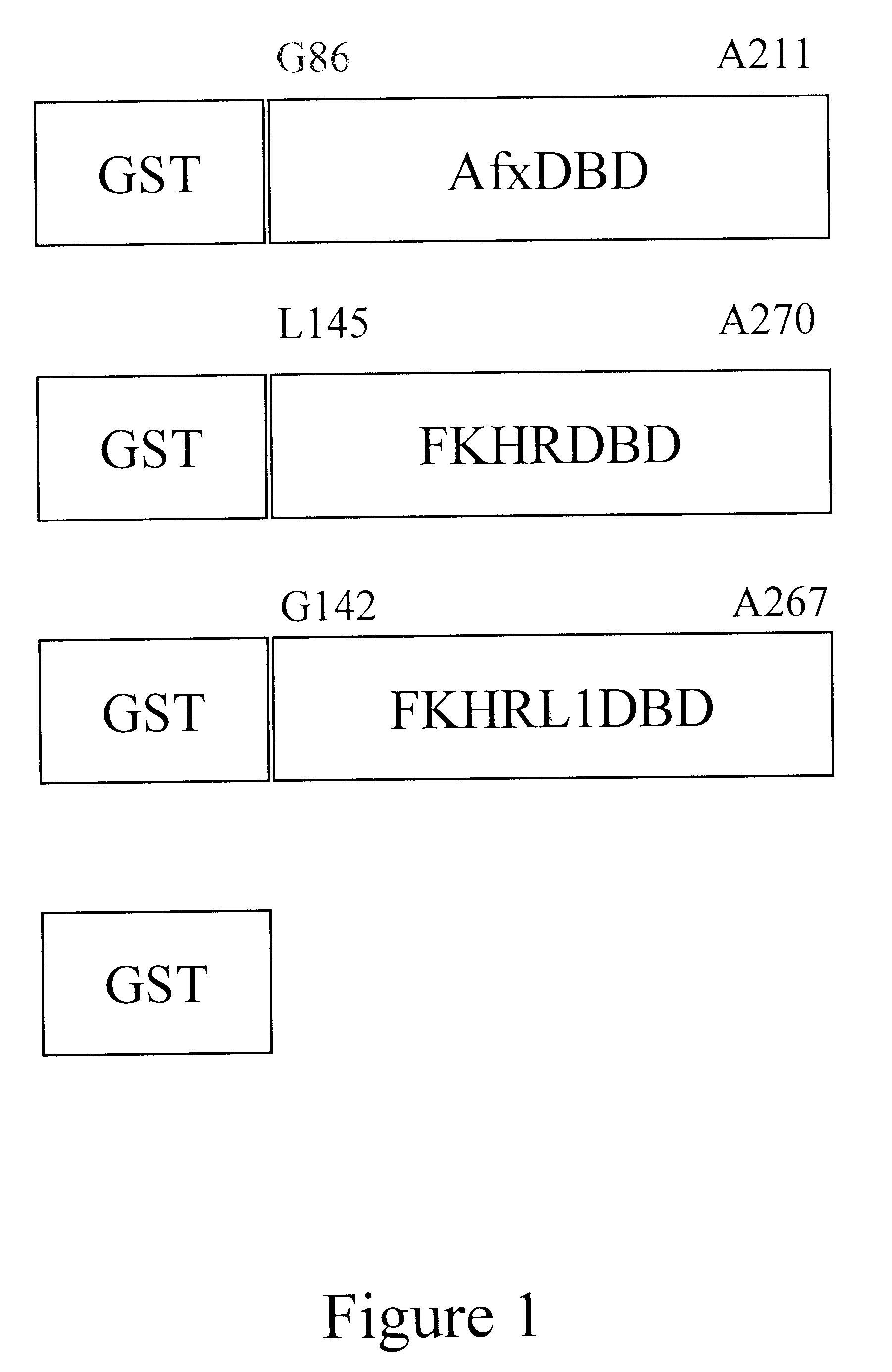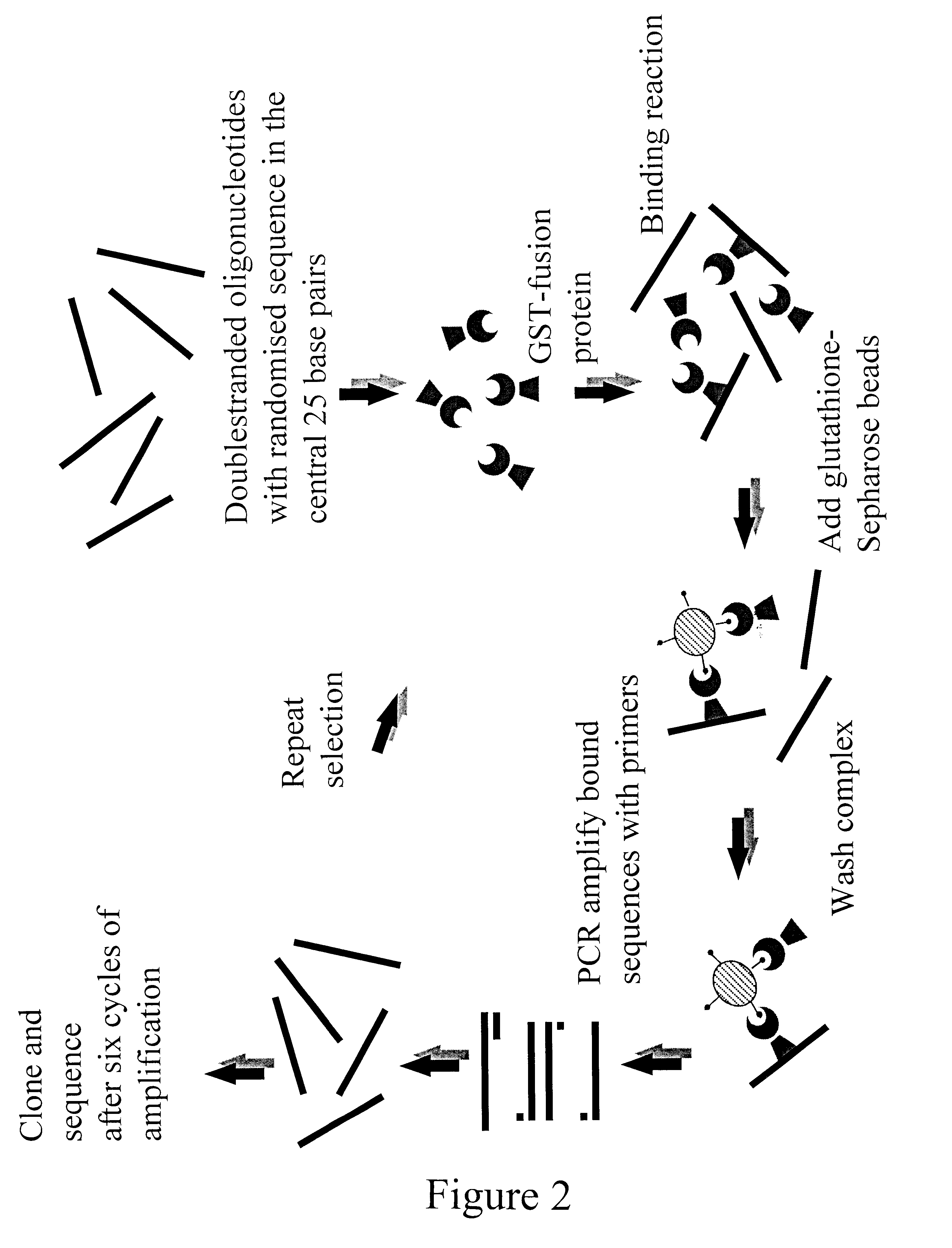Response element
a technology of insulin response and response element, applied in the field of diabetes and obesity, can solve the problems of lack of agreement on a single insulin response element, blindness, renal failure, lower limb amputation in adults, etc., and achieve the effect of facilitating the analysis of gene interaction
- Summary
- Abstract
- Description
- Claims
- Application Information
AI Technical Summary
Benefits of technology
Problems solved by technology
Method used
Image
Examples
example 1
I. Generation of Randomized Oligonucleotides
Sequence of the random oligonucleotide and primers (Scandinavian Gene Synthesis) used for DNA binding site selection procedure and sequencing:
N25: 5'CGCTCGAGGGATCCGAATTC(N)25TCTAGAAAGCTTGTCGACGC (SEQ ID NO:31);
N255'primer: 5'CGCTCGAGGGATCCGAATTC (SEQ ID NO:32);
N253'primer: 5'GCGTCGACAAGCTTTCTAGA (SEQ ID NO:33).
To obtain double-stranded oligonucleotides with randomized sequence in the central 25 base pairs as starting material for the selection procedure, 12 .mu.g of N25 was mixed with 10 .mu.g of N253'primer in 100 .mu.l of 10 mM Tris-Cl, pH 7.5, 10 mM MgCl2, 1 mM DTT. The solution was heated to 95.degree. C., followed by slow cooling in a water bath to 55.degree. C., and kept at this temperature for 30 minutes. Following annealing at 55.degree. C., the tube was transferred to 37.degree. C., 10 .mu.l of 10 mM dNTP (10 mM) and 2.5 .mu.l Klenow enzyme (Boehringer, 2 U / .mu.l) were added, and the incubation was continued at 37.degree. C. for 3...
example 2
Production of GST Fusion Proteins
The DNA binding domains (DBD) of Afx, FKHR, and FKHRL1, were expressed as GST-fusion proteins. For this, the DBDs of the fork head proteins were inserted into the BamHI site of the pGEX-2T-KB plasmid, to produce pGEX-DBD plasmids. The sequence of the inserted DNA fragments were confirmed by DNA sequencing, except for the C-terminal of FKHRL1DBD. This part was GC-rich, which made it difficult to sequence. Even after several attempts with different sequence analysis the last 15 nucleotides could not be determined. However, even though the C-terminal was not confirmed the plasmid construct was used in following experiments. The GST-fusion proteins and GST alone (control) (see FIG. 1) were expressed in E.coli. A SDS polyacrylamide gel electrophoresis analysis of the expression before and after IPTG induction shows expression of GST-fusion proteins of expected sizes.
The nucleotide sequence encoding the fusion protein GST-Afx-DBD is shown in FIG. 7, and th...
example 3
Generation of Randomized Oligonucleotide
To obtain the randomized oligonucleotides used as starting material in the selection of the DNA binding sites, single-stranded oligonucleotides with randomized sequences in the central 25 bases were converted to double-stranded oligonucleotide. The smear of bands observed in agarose gel underneath the 65-mer band presumably reflects partially converted double-stranded oligonucleotides.
I. Selection of DNA-binding Sites
Selection of DNA-binding sites for the fork head proteins, AFX, FKHR, and FKHRL1, was performed according to Pierrou et al. (S. Pierrou et al. (1995); Analytical biochemistry, 229, pp. 99-105), shown in FIG. 2. Binding reactions are set up with bacterial extract containing the GST-fusion protein, and double-stranded oligonucleotides for which the central 25 bp have been randomized. To minimize non-specific protein-DNA interactions, binding is done in the presence of high levels of poly(dI-dC)(poly(dI-dC). The GST fusion protein DN...
PUM
| Property | Measurement | Unit |
|---|---|---|
| pH | aaaaa | aaaaa |
| pH | aaaaa | aaaaa |
| concentration | aaaaa | aaaaa |
Abstract
Description
Claims
Application Information
 Login to View More
Login to View More - R&D
- Intellectual Property
- Life Sciences
- Materials
- Tech Scout
- Unparalleled Data Quality
- Higher Quality Content
- 60% Fewer Hallucinations
Browse by: Latest US Patents, China's latest patents, Technical Efficacy Thesaurus, Application Domain, Technology Topic, Popular Technical Reports.
© 2025 PatSnap. All rights reserved.Legal|Privacy policy|Modern Slavery Act Transparency Statement|Sitemap|About US| Contact US: help@patsnap.com



